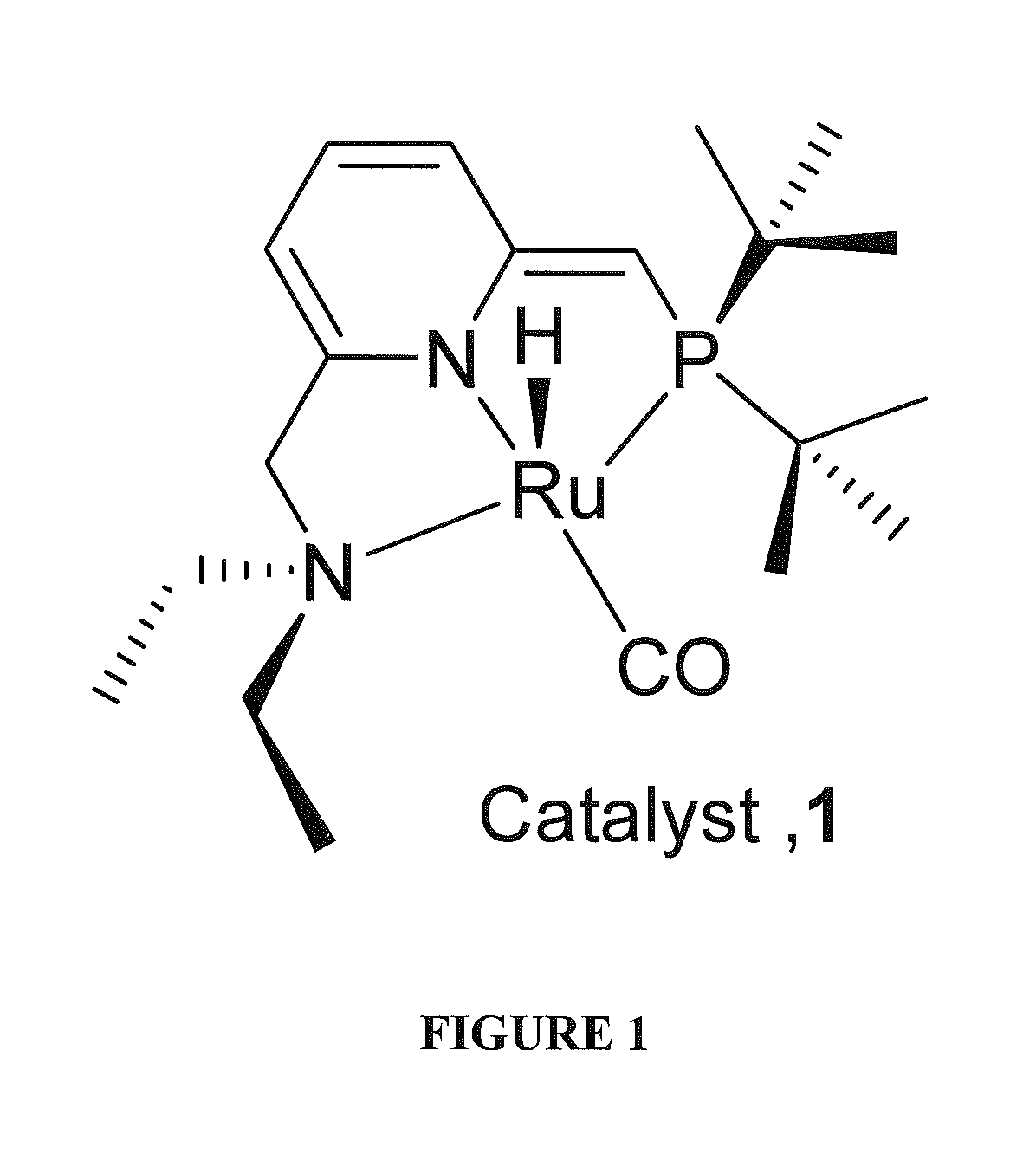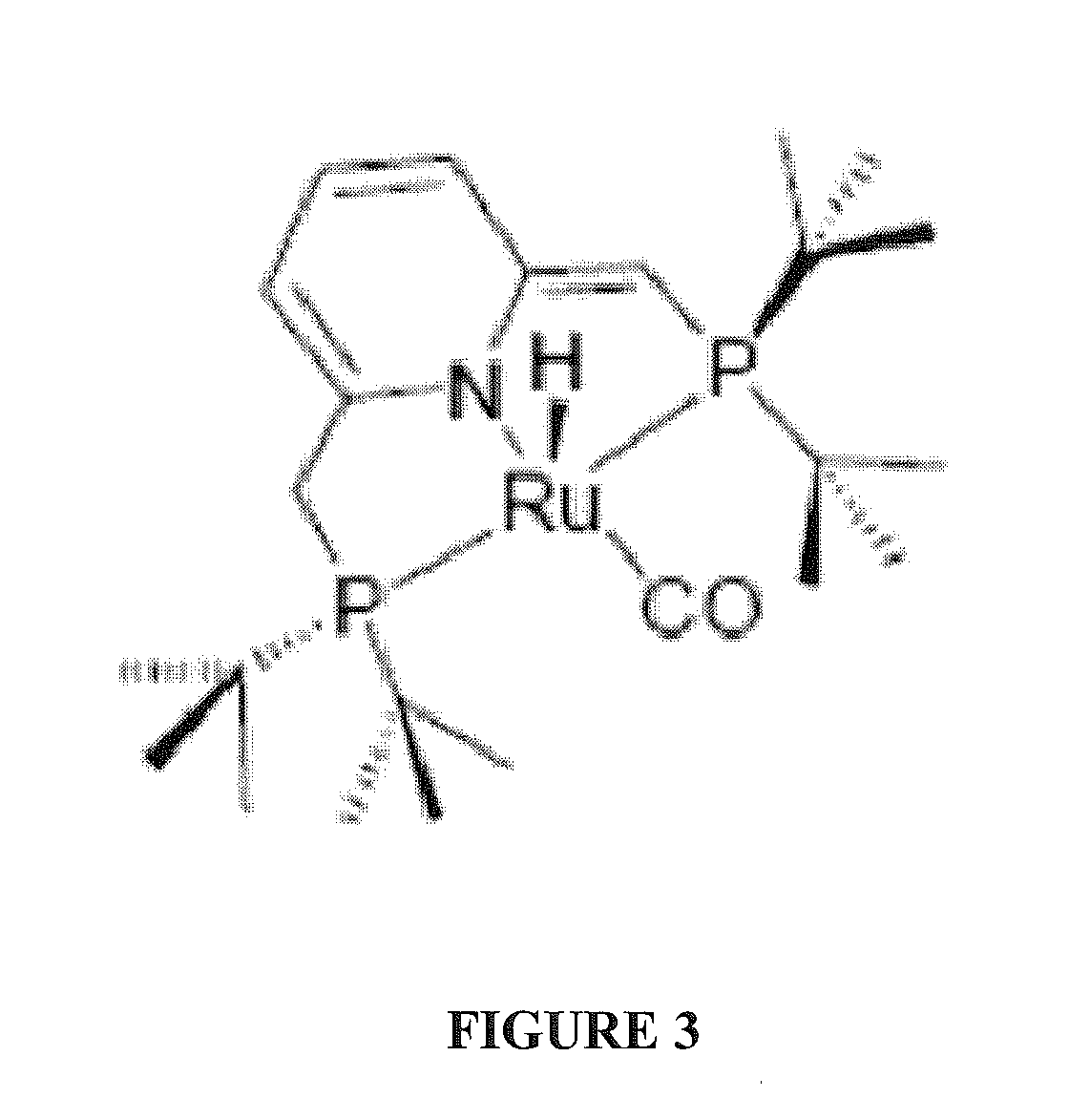Use of ruthenium complexes for formation and/or hydrogenation of amides and related carboxylic acid derivatives
- Summary
- Abstract
- Description
- Claims
- Application Information
AI Technical Summary
Benefits of technology
Problems solved by technology
Method used
Image
Examples
example 1
Representative Procedure for Catalytic Dehydrogenative Mono-Acylation of Primary Amines and Alcohols
[0202]This example provides a typical procedure for the catalytic dehydrogenative mono-acylation of primary amines with alcohols (Table 1): Complex RuH(CO)(PNN*) 1 (0.01 mmol), an alcohol (10 mmol), an amine (10 mmol) and toluene (3 mL) were taken in a Schlenk flask under an atmosphere of purified nitrogen in a Vacuum Atmospheres glove box. The flask was equipped with a condenser and the solution was refluxed with stirring in an open system under argon for the specified time (Table 1). After cooling to room temperature, the consumption of starting materials was checked by GC using a Carboxen 1000 column on a HP 690 series GC system.
Purification of amides in entries 1-3, and 10: After completion of reaction, the reaction mixture was cooled and allowed to stand at room temperature, during which the product amides crystallized from the solution. The solution was decanted and the solids w...
example 2
Hydrogenation of Amides to the Corresponding Alcohols and Amines
[0210]
[0211]Complex 1 was tested as a catalyst for the hydrogenation of amides. Thus, upon treatment of N-benzyl-2-methoxyacetamide with dihydrogen (10 atm) at 110° C. (bath temperature) in dry THF for 48 h with a catalytic amount of 1 (1 mol %), 62.7% of 2-methoxyethanol and 62.0% of benzyl amine were obtained. Performing the reaction at 140° C. using 1,4-dioxane as solvent did not significantly improve the yield (alcohol yield 66.3%). It was significant that the reaction was selective and the corresponding secondary amine was not observed. Results of some typical processes are shown in Table 3.
TABLE 3Selective Hydrogenation of Amides to Alcohols and Amines Using H2 catalyzed by pincer complex 1Yield (%)bEntryAlcoholAmine162.762.0266.3 66.8caComplex 1 (0.01 mol), amide (1 mmol), H2 (10 atm), and dry THF (2 ml) were heated in a Fischer-Porter tube at 110° C. (bath temperature) for 48 h.bYields of products were analyzed ...
example 3
Hydrogenation of Cyclic Di-Peptides
[0213]The process of the present invention can also be used for catalytic hydrogenation of di-peptides. For example, cyclic di-peptides can be hydrogenated to amino alcohols. In a general procedure, a 100 mL Fischer-Porter tube was charged with the catalyst 1 (0.02 mmol), the cyclic di-peptides (1.0 mmol) and THF (2 mL) under an atmosphere of purified nitrogen in a Vacuum Atmospheres glove box. The pressure tube was taken out of the glove box, and subjected to three successive cycles of pressurization / venting with H2 (3 atm), then pressurized with H2 (12 atm) and closed. The tube was placed behind a protective shield and the reaction mixture was heated in an oil bath at 110° C. with constant stirring for 60 h. After cooling to room temperature, excess H2 was vented off carefully and the product was determined by GC and GC-MS. Some representative results are presented in Table 4 hereinbelow.
TABLE 4Hydrogenation of cyclic di-peptides to amino alcohol...
PUM
| Property | Measurement | Unit |
|---|---|---|
| Equivalent mass | aaaaa | aaaaa |
| Structure | aaaaa | aaaaa |
| Electric charge | aaaaa | aaaaa |
Abstract
Description
Claims
Application Information
 Login to View More
Login to View More - R&D
- Intellectual Property
- Life Sciences
- Materials
- Tech Scout
- Unparalleled Data Quality
- Higher Quality Content
- 60% Fewer Hallucinations
Browse by: Latest US Patents, China's latest patents, Technical Efficacy Thesaurus, Application Domain, Technology Topic, Popular Technical Reports.
© 2025 PatSnap. All rights reserved.Legal|Privacy policy|Modern Slavery Act Transparency Statement|Sitemap|About US| Contact US: help@patsnap.com



